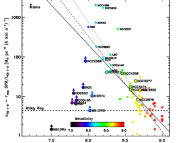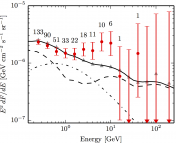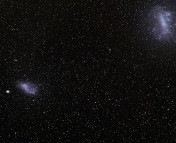Authors: Michael Koss, Laura Blecha, Richard Mushotzky, Chao Ling Hung, Sylvain Veilleux, Benny Trakhtenbrot, Kevin Schawinski, Daniel Stern, Nathan Smith, Yanxia Li, Allison Man, Alexei V. Filippenko, Jon C. Mauerhan, Kris Stanek, David Sanders
Title: SDSS1133: An Unusually Persistent Transient in a Nearby Dwarf Galaxy
First Author’s Institution: ETH Zurich
The space between galaxies, long thought to be a near empty void, is now rapidly being revealed to be home to a host of astronomical phenomena. We’ve seen stars flying free of their galaxies, and discovered that the Universe is built on a cosmic web of dark matter. Now astronomers may have added a new type of intergalactic resident to the list: a super-massive black hole, a million times the mass of the Sun, kicked out from its home galaxy.
The search for such evicted black holes was prompted by the budding field studying gravitational waves, ripples in space time caused by the interactions of massive objects. Some theories suggested that in a merger between two super massive black holes, which are thought to be present at the core of most, if not all, galaxies, the resulting gravitational waves would carry away some of the momentum in the collision. If this caused the remaining momentum to be asymmetric, the newly merged black hole could be given a “kick,” a substantial increase in speed in one direction. Depending on the mass of the host galaxy, this could be enough to throw the black hole out into intergalactic space.
The immense gravity of the black hole means that it would carry with it an accretion disc of gas and dust. As the material in the disc fell on to the black hole, the released energy would shine out across a huge wavelength range. This means that, if the gravitational wave theories are correct, we should be able to observe such objects from the Earth.
However so far, with the exception of a few tentative candidates, the search for escaped black holes has drawn a blank. The authors of this paper think they may have finally found one.

Top: The candidate escaped back hole, SDSS1133, and its host galaxy, Mrk 177, observed in two different telescope filters. Bottom: A close up of the centre of Mrk 177, with signs of two separate cores created in the events leading up to the expulsion of the black hole.
The authors concentrated their search around dwarf galaxies, as the lower mass of the galaxy should make it easier for a black hole to escape to an observable distance. Their candidate ejected black hole is a bright point of light known as SDSS1133, which sits about two and a half thousand light years from a nearby dwarf galaxy, Mrk 117. This had been observed before now, but, thanks to a non detection in 2005, had been classified as a supernova.
To show that this diagnosis was incorrect and that SDSS1133 was actually escaped black hole, the authors amassed a host of observations stretching back as far as 1950. Combining them with their own data allowed them to see how the brightness of SDSS1133 had changed over the past 63 years. Whereas a supernova should quickly fade away, SDSS1133 had stayed bright for all of that time- in fact it had even got brighter in some observations. The bright, near constant light from the object, which was constrained to an area no larger than a few tens of light years, was entirely consistent with SDSS1133 being an escaped black hole, together with its accretion disc.
In addition to the half-century’s worth of images, the authors also took several spectra of the object. Using Keck, one of the largest telescopes in the world, they found a number of features that matched observation of black holes at the cores of many other galaxies. Emission lines from super-hot iron and calcium matched what was expected from an active black hole, and the lack of features that would have been observed if stars had been present supported the idea that this particular black hole was alone in space.
More spectra of SD1133, obtained at different times over the past decade, could provide one final test. By measuring the width of the emission lines the authors could work out the Doppler shift of the material in the accretion disc, which is induced by the orbital velocity of the disc around the black hole. The orbital velocity is proportional to the mass of the back hole, so these measurements can be used to get a rough idea of that mass. If each spectrum had given a different result for the mass of the black hole then the hypotheses that this was a lone black hole would be in doubt. In the end, the answer came out the same each time- roughly one million times the mass of the Sun.
So have the authors found the first super massive black hole to be kicked out of its galaxy? The observations seem to match it, but there is another possible explanation. Giant stars known as luminous blue variable stars (LBVs), such as the famous Eta Carinae, share many similar observational properties with active back holes. If such a star had been ejected from Mrk 117, then exploded in a supernova, it could match all of the observations of SDSS1133. It would, however, be the longest-lived LBV known, with an unusually bright supernova finishing it off.
The authors conclude that, whilst SDSS1133 could be just an ejected LBV, the bulk of the evidence is in favour of it being the first discovery of a super massive back hole kicked out of its home galaxy. Continued observations of the object will be tested against predictions of how such lonely black holes should evolve, allowing astronomers to solve the mystery for good.





Hi. Thanks for your (and others’) posts. Astrobites is a recent find (Feedly recommendation) which I, as a layman, think strikes a nice balance between popular astronomy news outlets and the deluge that is astro-ph.
Regarding this release, could you tell me how one could rule out the observation of the ‘million solar mass’ and declare it instead as LBV? To be more precise, what are those features that are common to SMBHs and LBVs, which are at most a couple of hundred solar masses?